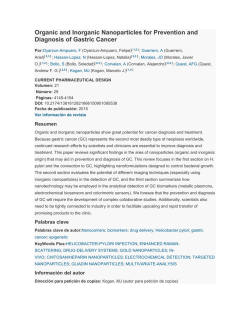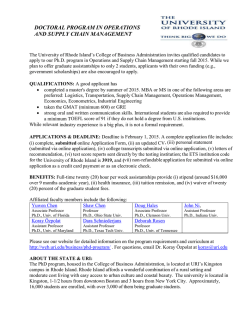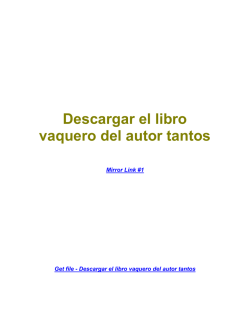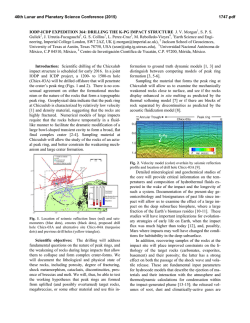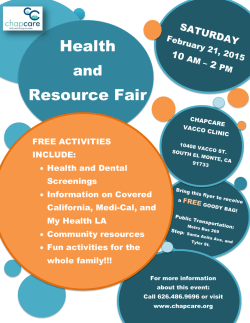
Synthesis, spectroscopic characterization and DFT study of
Synthesis, spectroscopic characterization and DFT study of dinuclear ruthenium sawhorse-type complexes derived from the reaction of trinuclear aggregates and (Z)-5arylidenerhodanines Por:Paredes-Gil, K (Paredes-Gil, Katherine)[ 1,2,3 ] ; Galarza, E (Galarza, Esperanza)[ 2 ] ; Cedeno, DL (Cedeno, David L.)[ 4 ] ; Insuasty, B (Insuasty, Braulio)[ 5 ] ; Abonia, R (Abonia, Rodrigo)[ 5 ] JOURNAL OF COORDINATION CHEMISTRY Volumen: 69 Número: 15 Páginas: 2291-2307 DOI: 10.1080/00958972.2016.1202936 Fecha de publicación: 2016 Ver información de revista Resumen The synthesis of dinuclear ruthenium sawhorse-type complexes [Ru-2(-ArCH:Rhod)(2)(CO)(4)](n) 12a-e and [Ru-2(ArCH:Rhod)(2)(-ArCH:Rhod)(2)(CO)(4)] 13a-e through reaction of [Ru3(CO)(10)(NCMe)(2)] and [Ru-3(CO)(12)] and the corresponding (Z)-5-arylidenerhodanines (ArCH:Rhod) 10a-e, respectively, are reported. These complexes are arranged in a sawhorse structure in which two bridged (Z)-5-arylidenerhodanines coordinate to the metals using sulfur and nitrogen of the rhodanine ring. A Density Functional Theory method was used to gain insight into the polymerization process by calculating dimerization Gibbs energies (G(dim)). Values between 10.7 and -5.3kcalmol(-1) indicate that dimerization is a spontaneous process. A reaction pathway for formation of the sawhorse compounds [Ru-2(-ArCH:Rhod)(2)(CO)(4)] was calculated and the rate-determining step for the mechanism is coordination of a second (Z)-5-arylidenerhodanine ligand with activation energies between 41.1 and 47.8kcalmol(-1). In order to understand the apparent thermodynamic favorability of the fragmentation step, we calculated the fragmentation energy (E-Frag) for the key intermediate and its energetic contributors, the interaction energy, E-int and the reorganization energy, E-reorg. Low values of E-Frag imply that the fragmentation is thermodynamically facile. Large values of E-int are countered by opposite and large values of Ereorg which indicate that the cleavage of the trimetallic intermediate aggregate is determined by the nature of the ligand and the balance between its interaction with the metal and the extent of structural reorganization. Palabras clave Palabras clave de autor:Sawhorse-type complexes; ruthenium cluster carbonyls; DFTmechanism; fragmentation energy KeyWords Plus:TRIRUTHENIUM CARBONYL CLUSTERS; AB-INITIO PSEUDOPOTENTIALS; CARBOXYLATE COMPLEXES; CATALYTIC-ACTIVITY; CRYSTALSTRUCTURE; BASIS-SETS; LIGANDS; RU-3(CO)(12); DERIVATIVES; RU3(CO)12 Información del autor Dirección para petición de copias: Paredes-Gil, K (autor para petición de copias) Univ Andres Bello, Fac Ciencias Exactas, Relativist Mol Phys ReMoPh Grp, Santiago, Chile. Dirección para petición de copias: Paredes-Gil, K (autor para petición de copias) Univ Valle, Dept Quim, Grp Invest Sintesis Organometal & Catalisis, GISIOMCA, Cali, Colombia. Dirección para petición de copias: Paredes-Gil, K (autor para petición de copias) Univ Chile, Fac Ciencias, Dept Quim, Santiago, Chile. Direcciones: [ 1 ] Univ Andres Bello, Fac Ciencias Exactas, Relativist Mol Phys ReMoPh Grp, Santiago, Chile [ 2 ] Univ Valle, Dept Quim, Grp Invest Sintesis Organometal & Catalisis, GISIOMCA, Cali, Colombia [ 3 ] Univ Chile, Fac Ciencias, Dept Quim, Santiago, Chile [ 4 ] Illinois State Univ, Dept Chem, Normal, IL 61761 USA [ 5 ] Univ Valle, Dept Quim, Grp Invest Compuestos Heterocicl, Cali, Colombia Direcciones de correo electrónico:[email protected] Financiación Entidad financiadora Número de concesión COLCIENCIAS Universidad del Valle Illinois State University FONDECYT 1140503 1150629 project CONICYT AKA ERNC-001 fellowship "Program for International Mobility of Researchers and Innovators to Events and Short Term Stays" of COLCIENCIAS Ver texto de financiación Editorial TAYLOR & FRANCIS LTD, 2-4 PARK SQUARE, MILTON PARK, ABINGDON OR14 4RN, OXON, ENGLAND Categorías / Clasificación Áreas de investigación:Chemistry Categorías de Web of Science:Chemistry, Inorganic & Nuclear Información del documento Tipo de documento:Article Idioma:English Número de acceso: WOS:000381301800005 ISSN: 0095-8972 eISSN: 1029-0389 Información de la revista Impact Factor: Journal Citation Reports® Otra información Número IDS: DT2HQ Referencias citadas en la Colección principal de Web of Science: 60 Veces citado en la Colección principal de Web of Science: 0
© Copyright 2026
